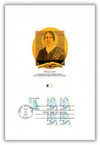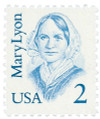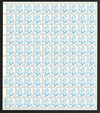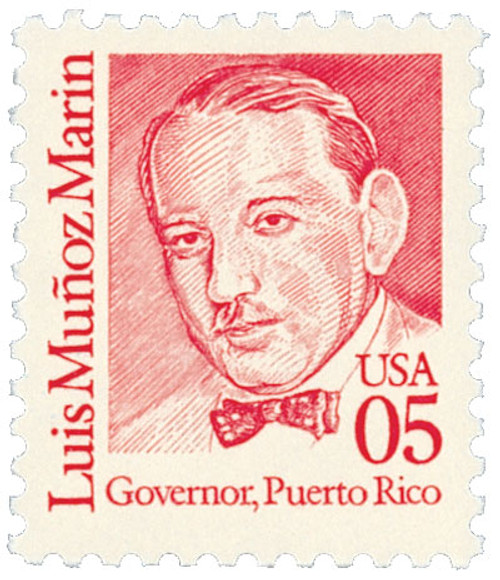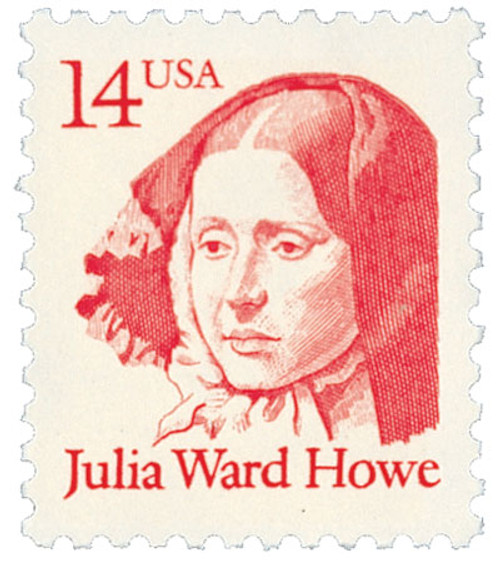
# 2169 - 1987 2c Great Americans: Mary Lyon
U.S. #2169
1987 2¢ Mary Lyon
Great Americans
- 37th stamp in Great Americans Series; 7th woman
- Issued on Lyon’s 190th birthday and 150th anniversary of Mount Holyoke College
Stamp Category: Definitive
Series: Great Americans
Value: 2¢, used for make-up postage
First Day of Issue: February 28, 1987
First Day City: South Hadley, Massachusetts
Quantity Issued: [Indicate if this is an estimate]
Printed by: Bureua of Engraving and Printing
Printing Method: Engraved
Format: Panes of 100
Perforations: 11
Color: Bright blue
Why the stamp was issued: This 2¢ stamp is what the USPS calls “change maker” postage. These stamps with denominations of 1¢ through 6¢ are produced to make up the wide variety of rates for third-class parcel post, which has many combinations of charges for weight and distance. These stamps were also useful when first-class rates went up, before the USPS could release stamps at the new rate.
About the stamp design: This stamp was designed by Ron Adiar. He and his twin brother Don are the first twins to both design US stamps. Adair based his portrait on several images of Lyon, with the majority of it based on an 1845 daguerreotype.
First Day City: The First Day ceremony for this stamp was held at the Chapin Auditorium at Mount Holyoke College, which Lyon founded in South Hadley, Massachusetts.
About the Great Americans Series: The Great Americans Series was created to replace the Americana Series. The new series would be characterized by a standard definitive size, simple design, and monochromatic colors.
This simple design included a portrait, “USA,” the denomination, the person’s name, and in some cases, their occupation or reason for recognition. The first stamp in the new series was issued on December 27, 1980. It honored Sequoyah and fulfilled the new international postcard rate that would go into effect in January 1981.
The Great Americans Series would honor a wider range of people than the previous Prominent Americans and Liberty Series. While those series mainly honored presidents and politicians, the Great Americans Series featured people from many fields and ethnicities. They were individuals who were leaders in education, the military, literature, the arts, and human and civil rights. Plus, while the previous series only honored a few women, the Great Americans featured 15 women. This was also the first definitive series to honor Native Americans, with five stamps.
The Bureau of Engraving and Printing (BEP) produced most of the stamps, but private firms printed some. Several stamps saw multiple printings. The result was many different varieties, with tagging being the key to understanding them. Though there were also differences in perforations, gum, paper, and ink color.
The final stamp in the series was issued on July 17, 1999, honoring Justin S. Morrill. Spanning 20 years, the Great Americans was the longest-running US definitive series. It was also the largest series of face-different stamps, with a total of 63.
Click here for all the individual stamps and click here for the complete series.
History the stamp represents: Mary Lyon was born on February 28, 1797, near Buckland, Massachusetts. As a child, Lyon attended local schools off and on, though she eventually would teach at those schools. Her irregular education as a child inspired her to a lifelong drive to give young girls from poor families better educational opportunities than she had.
At a time when few women received even basic instruction, Lyon determined to learn as much as she could. She began teaching when she was just 17 years old and soon realized she needed more education herself. Lyon said she gained “knowledge by the handfuls,” by attending lectures and taking courses at colleges for men (sometimes a three-day trip). As she continued to learn and teach, she began envisioning a school that offered rigorous academics and was available to women from all walks of life.
In the midst of a severe economic depression, Lyon wrote ads, raised money, convinced businessmen to support her, created a curriculum, selected the school’s location, oversaw construction of the building, hired teachers, and chose students. She was ridiculed for her ambition and told she was wasting her time. In spite of the hard economic times, she was able to persuade wealthy, influential men to back her college for women.
On November 8, 1837, Lyon opened Mount Holyoke Female Seminary to its first 80 students. They were required to take seven courses in science and mathematics before graduating. Lyon introduced laboratory experiments, a novel idea in women’s education, and field trips to collect specimens of plants and rocks.
Lyon was an early proponent of physical education for women, and the attendees were required to walk a mile each day and perform calisthenics, a form of exercise that combines stretching and strengthening movements. The girls were required to perform chores to keep the tuition down. The cost of $60 per year was affordable to families of modest means. The school was a success – proving that such a school for women could survive, and that women were just as intellectually capable as men.
Over time, the school grew, and by the mid 1800’s, many female teachers in the East were Mount Holyoke graduates. Lyon’s model was followed by other schools, giving young women the opportunity to obtain a higher education throughout the country and around the world. In 1905, Mary Lyon was inducted into the Hall of Fame for Great Americans for her innovative college.
Today, Mount Holyoke College (it was renamed in 1893) has more than 2,000 students enrolled and is still known for its strong academic program. Mount Holyoke College offers two years of general education in liberal arts and two years of concentrated studies in one of twenty-four academic areas.
U.S. #2169
1987 2¢ Mary Lyon
Great Americans
- 37th stamp in Great Americans Series; 7th woman
- Issued on Lyon’s 190th birthday and 150th anniversary of Mount Holyoke College
Stamp Category: Definitive
Series: Great Americans
Value: 2¢, used for make-up postage
First Day of Issue: February 28, 1987
First Day City: South Hadley, Massachusetts
Quantity Issued: [Indicate if this is an estimate]
Printed by: Bureua of Engraving and Printing
Printing Method: Engraved
Format: Panes of 100
Perforations: 11
Color: Bright blue
Why the stamp was issued: This 2¢ stamp is what the USPS calls “change maker” postage. These stamps with denominations of 1¢ through 6¢ are produced to make up the wide variety of rates for third-class parcel post, which has many combinations of charges for weight and distance. These stamps were also useful when first-class rates went up, before the USPS could release stamps at the new rate.
About the stamp design: This stamp was designed by Ron Adiar. He and his twin brother Don are the first twins to both design US stamps. Adair based his portrait on several images of Lyon, with the majority of it based on an 1845 daguerreotype.
First Day City: The First Day ceremony for this stamp was held at the Chapin Auditorium at Mount Holyoke College, which Lyon founded in South Hadley, Massachusetts.
About the Great Americans Series: The Great Americans Series was created to replace the Americana Series. The new series would be characterized by a standard definitive size, simple design, and monochromatic colors.
This simple design included a portrait, “USA,” the denomination, the person’s name, and in some cases, their occupation or reason for recognition. The first stamp in the new series was issued on December 27, 1980. It honored Sequoyah and fulfilled the new international postcard rate that would go into effect in January 1981.
The Great Americans Series would honor a wider range of people than the previous Prominent Americans and Liberty Series. While those series mainly honored presidents and politicians, the Great Americans Series featured people from many fields and ethnicities. They were individuals who were leaders in education, the military, literature, the arts, and human and civil rights. Plus, while the previous series only honored a few women, the Great Americans featured 15 women. This was also the first definitive series to honor Native Americans, with five stamps.
The Bureau of Engraving and Printing (BEP) produced most of the stamps, but private firms printed some. Several stamps saw multiple printings. The result was many different varieties, with tagging being the key to understanding them. Though there were also differences in perforations, gum, paper, and ink color.
The final stamp in the series was issued on July 17, 1999, honoring Justin S. Morrill. Spanning 20 years, the Great Americans was the longest-running US definitive series. It was also the largest series of face-different stamps, with a total of 63.
Click here for all the individual stamps and click here for the complete series.
History the stamp represents: Mary Lyon was born on February 28, 1797, near Buckland, Massachusetts. As a child, Lyon attended local schools off and on, though she eventually would teach at those schools. Her irregular education as a child inspired her to a lifelong drive to give young girls from poor families better educational opportunities than she had.
At a time when few women received even basic instruction, Lyon determined to learn as much as she could. She began teaching when she was just 17 years old and soon realized she needed more education herself. Lyon said she gained “knowledge by the handfuls,” by attending lectures and taking courses at colleges for men (sometimes a three-day trip). As she continued to learn and teach, she began envisioning a school that offered rigorous academics and was available to women from all walks of life.
In the midst of a severe economic depression, Lyon wrote ads, raised money, convinced businessmen to support her, created a curriculum, selected the school’s location, oversaw construction of the building, hired teachers, and chose students. She was ridiculed for her ambition and told she was wasting her time. In spite of the hard economic times, she was able to persuade wealthy, influential men to back her college for women.
On November 8, 1837, Lyon opened Mount Holyoke Female Seminary to its first 80 students. They were required to take seven courses in science and mathematics before graduating. Lyon introduced laboratory experiments, a novel idea in women’s education, and field trips to collect specimens of plants and rocks.
Lyon was an early proponent of physical education for women, and the attendees were required to walk a mile each day and perform calisthenics, a form of exercise that combines stretching and strengthening movements. The girls were required to perform chores to keep the tuition down. The cost of $60 per year was affordable to families of modest means. The school was a success – proving that such a school for women could survive, and that women were just as intellectually capable as men.
Over time, the school grew, and by the mid 1800’s, many female teachers in the East were Mount Holyoke graduates. Lyon’s model was followed by other schools, giving young women the opportunity to obtain a higher education throughout the country and around the world. In 1905, Mary Lyon was inducted into the Hall of Fame for Great Americans for her innovative college.
Today, Mount Holyoke College (it was renamed in 1893) has more than 2,000 students enrolled and is still known for its strong academic program. Mount Holyoke College offers two years of general education in liberal arts and two years of concentrated studies in one of twenty-four academic areas.







